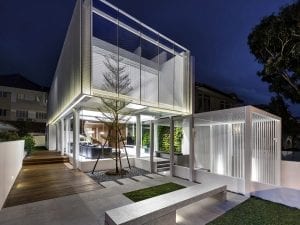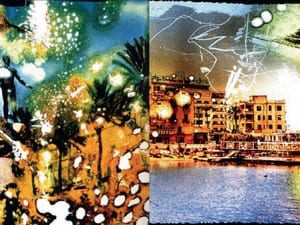For architect Tom Kundig, design practice is an encounter with context, materials and nature, where structures become a part of their environment.
In a quiet clearing of a temperate rain forest in a national park in west Washington sits the Tom Kundig-designed Sol Duc Cabin, a steel-panelled structure, inscrutable on rst encounter. Its shape, a rectangular box on stilts, recalls a hide for bird watching; it is not necessarily camouflaged, but neither does it draw undue attention to itself. Its materials are mild steel panels that weather. There’s modesty about the structure for a project by a star architect; the attention is focused on the encounter of the building with its environment.
Born in 1954 and based in Seattle, with his architectural practice Olson Kundig, Tom Kundig has emerged in recent years as one of the most distinctive practitioners of a context-based approach to architecture. In new monograph Works, published this year by Princeton University Press, recent projects by Kundig are contextualised not only within his broader work but also in the form of wider conversations and essays through which emerges an architect whose design philosophy seems to be rooted in response and conversation. Even the title of the book, Works, is characteristic of an economy and precision that pervades Kundig’s practice. While on the surface it alludes to the text’s organisational principle of focusing on a number of buildings from the last few years, it also refers to a pragmatic approach that underpins his architecture: the test of a building is in how it “works”, and its connection to its environment and users.
Sol Duc Cabin, then, exudes an air of indestructability, which it has to, in order to survive uninhabited for long periods of time and to resist the risks of flooding, human and animal interference, and damp, all of which are inherent in its surroundings. However, the process of construction itself also responds to its location by taking measures such as prefabricating the structure in order to minimise environmental impact through wastage and site disruption. Context, then, is at the heart not just of the structure’s use, but its wider function in society: what we want our buildings to be. At its most trimmed-back level, the Sol Duc Cabin is built as a shelter. Kundig remarks: “Residential design is the origin of all architecture; home is our essential shelter, and along with food and water, constitutes what is necessary for human life. Home is a place of refuge, memory, family and tradition. There has been a persistent belief among architects that as you grow as an architect you eventually graduate from residential design to become a commercial or institutional architect. I couldn’t disagree more with this attitude.”
Kundig’s approach isn’t just based on theory, it also has a practical dimension. For Kundig, residential design is of paramount importance, because it does not have any restrictions, and rather than thinking of it terms of “essential shelter”; Kundig’s non-residential projects are in uenced by this idea because he taps into the demands of a building.
He believes that: “There are important lessons to be learned from residential design which can profoundly influence non-residential design – comfort, intimacy and materiality among them. I try to bring what I learn from residential design to non-residential design, to create spaces that are both comfortable and inspiring. Bringing joy and pleasure to the design of public spaces celebrates our sense of community, and builds upon our notions of family.”
Context doesn’t just imply the site or the environment of a building but also its use and history. For his Haub Galleries Extension to the Tacoma Art Museum (2014), Kundig made a structure that draws on the history of the city as a terminus of the Northern Pacific Railroad to create a 34-ft-tall entrance canopy made of aluminium and stainless steel, which acknowledges it as a major intersection past and present. The project also used recycled Richlite, a paper and resin compound that is extremely tough and which is produced by a company based in Tacoma. As well as doubling the space for galleries, the extension serves as a space for offices, including areas where the public, including children, are encouraged to produce art. The project also involved addressing the experience of the building’s users; visitors had previously reported difficulty finding the front doors.
Kundig’s approach to using natural and recycled materials in his work is in line with ecological considerations. It seems to emerge not from a didactic commitment but rather from an attachment to treating all aspects of the process with authenticity and integrity. His use of recycled and found material is both a practical and poetic choice. It makes for buildings that embody a relation to time and history, as we do. The architect notes that “As materials age, they develop their own history – a patina that is honestly earned and which reveals the history of that object’s creation, making and use. Reusing materials, or simply leaving them in place and incorporating them into new space, acknowledges the continuity of the world around us… everything is connected.”
In particular, Kundig is drawn to steel, which has formed the vocabulary for many of his projects, from the Haub Gallery at the Tacoma Art Museum to the Pole Pass Cabin (2013).
Of steel, Kundig has written: “steel is a great material … it’s tough, malleable and morphable. Almost anything you can imagine, you can fabricate out of steel. It allows you to explore and to experiment, and it can be repurposed.” Pole Pass Cabin combines steel with charred cedar siding which is deep and mellow in colour, developed using an ancient Japanese method called shou-sugi-ban. While serving an aesthetic function of giving the wood a deep colour and character, it also protects it from rot and infestation.
In Kundig’s work, material is always a response to context, and his design philosophy emphasises the importance of an encounter with a site. As Kundig has remarked: “If you start with the belief in the primacy of the site, then material choices become a direct response to that particular place. I think it is important not to compete with the landscape and to acknowledge the place of architecture within the larger space.” In one of his most well-received residential projects, The Pierre (2010) in Lopez Island, Washington, the house itself almost disappears into the rocky territory of the distinctive landscapes, existing not to dominate or eradicate the surrounding environment but rather taking its place in a balanced encounter with and around its setting.
Studhorse (2012) in Winthrop, Washington state, is another example of a context-based approach, in which the role of the architect is to respond not just to the demands of the brief, but also the environment itself. In Studhorse, this process was complicated by the extreme environmental and climactic variances of the location, a high, glacially formed landscape where there are climactic extremes of hot and cold. A particular challenge for the building, then, was to provide protection from the elements, which led Kundig to select materials for the outside of the building that are “tough as nails – strong enough to handle the harsh natural setting – while the inside is cosy as a sleeping bag.” The twist to this project, however, is that while it entailed Kundig imaginatively responding to the immediate environment of the landscape, the building itself makes similar demands on the home’s inhabitants. Consisting of four buildings centred around a courtyard and built around a large rock that was present on the site already, Studhorse further encourages the residents to engage with the landscape by making them unavoidably venture outside in order to be inside. Kundig says: “As a second home, Studhorse wasn’t burdened with the same constraints as a primary residence, which allowed the architecture to be more adventurous and sometimes inconvenient. These same attitudes force the occupants to engage with their surroundings, which is the whole point of being in this type of environment in the first place.”
Kundig has written of what he calls “the ‘macro to micro’ phenomenon, where the building encourages reflection on its big ideas and at the same time, enjoyment of its many details.” Nowhere is Kundig’s commitment to the minutiae of a building’s design more evident than in his hardware collection, which has been developed with the same attention to the individual and the particular experience as any of his large-scale projects. As he observes: “The parts of a building that you touch, such as doors, knobs, etc. form extensions of our bodies and connect us to our surroundings. The hardware collection is meant to celebrate that connection.”
Located in Maui, a popular destination for surfing in Hawaii, Slaughterhouse Beach House (2009) has its roots in the traditional surfing hut. Kundig expands the concept into three connected huts: one providing general living quarters, one with guest suites, and a third main sleeping area. The collection of buildings set low embodies a sense of community and collective space within the building, as well as providing for guest privacy. The attention is drawn not just to the spaces themselves but to the way they are connected and the process that has to be undertaken to move between spaces. To get from the general living area to the bedrooms involves and invokes an interaction with the environment. In this sense, Slaughterhouse Beach House suggests a relationship between private and public space, inside and outside. This is worked into the fabric of the building. The structure’s walls are constructed from rammed earth. In this process, different local earth-based mixtures are packed together, and the resulting striated layers are clearly visible both inside and outside the building. For this reason, the walls settle into the landscape, they require little maintenance, are virtually reproof, and also provide a strong barrier to sound.
In his exploration of the relation of outside to inside space, Kundig has spoken of formative experiences as a mountain climber: “I spent my youth outside hiking and climbing, so the idea of making a building connect to the outdoors seems as natural as breathing. Engagement with your surroundings becomes the yin to the yang of the safety within. It is a search for balance: in order to feel hot, you have to feel cold; in order to feel safe, you have to feel fear; and so on.”
Achieving this balance by emphasising an encounter and conversation between his projects and the context in which they stand, Kundig has developed not just a distinctive style as an architect but more importantly a rigorous process and practice of engaging with the spaces which we inhabit.
Words Colin Herd
Tom Kundig: Works is now available from Princeton Architectural Press.





